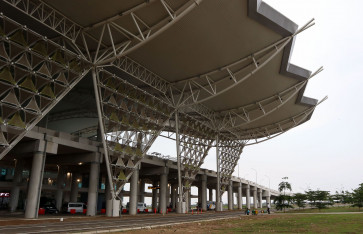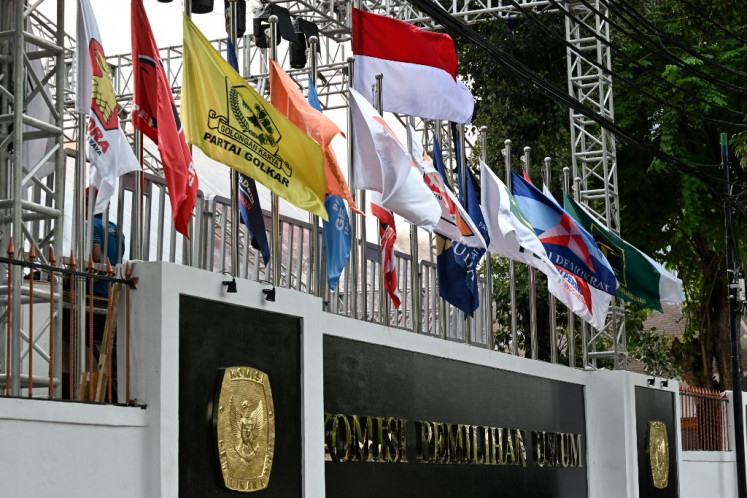Popular Reads
Top Results
Can't find what you're looking for?
View all search resultsPopular Reads
Top Results
Can't find what you're looking for?
View all search resultsPLN needs to triple electricity supply in Sulawesi to power nickel smelters
High-wire act: Workers install a power grid in Pombewe village, Sigi, Central Sulawesi
Change text size
Gift Premium Articles
to Anyone
H
igh-wire act: Workers install a power grid in Pombewe village, Sigi, Central Sulawesi. State eletricity firm PLN would have to triple its power supply in Sulawesi to meet the electricity needs of a number of nickel smelting plants currenty under construction on the island. (Antara/Basri Marzuki)
To power an incoming tide of metal smelters, the nickel-rich Central Sulawesi and Southeast Sulawesi provinces would need an additional power supply of 1,556 megawatts (MW), nearly three times more than their current combined capacity of 557 MW.
Spearheading power fulfillment efforts, state electricity firm PLN plans to double the construction of new power plants and integrate the electric grids of all six provinces on the island.
“Why are we suddenly building so much power? Because there’s been a change in government mining policies,” said PLN Sulawesi director Syamsul Huda during a discussion about the region’s preparedness for new smelters on Dec. 20.
Syamsul was referring to the 2009 Coal and Mineral Mining Law and its supporting Energy and Mineral Resources Ministerial Regulation No. 11/2019 that mandates all nickel ore to be refined domestically instead of being exported in raw form, starting January this year.
Central and Southeast Sulawesi, the heartland of domestic nickel mining, are to host 19 new smelters with a combined annual input capacity for 45.95 million tons as a direct result of the regulation. The largest smelter, being built by China’s Virtue Dragon Nickel, is to have a 7.2 million-ton capacity once it becomes operational in 2021.
“We advise mining companies to prioritize getting electricity from PLN, but since the mining companies have commercial operation deadlines, only if PLN cannot supply the electricity would they be advised to build their own power plants,” noted the energy ministry’s mineral business development director, Yunus Saefulhak.
PLN plans to increase lower Sulawesi’s production capacities to 3,031 MW by 2022, then to 3,842 MW by 2024. Most of the power is to come from coal-fired power plants, as per the company’s latest electricity procurement plan (RUPTL). The company is only slated to add hydropower plants starting in 2025.

The utility company also integrated on Oct. 8 the electricity grids throughout the island’s southern half, connecting all provinces except Gorontalo and North Sulawesi, which are the next two areas that the company is to work on.
Ceria Nugraha Indotama is one of the many nickel mining companies involved in Southeast Sulawesi. The company is developing a smelter to process 50 million tons of nickel each year, which would require a reliable 350 MW power source.
The company expects to pay 8 US cents per kilowatt hour (kWh) for PLN’s electricity. The rate matches the government-sanctioned one for medium voltage industries of Rp 1,115 (8 US cents) per kWh, the third lowest such rate among the six major Southeast Asian economies.
“Compared to building our own power plants, which would be cheaper — about 4 US cents per kWh — we would also have to bear external costs, so it comes to about the same rate,” Ceria chief executive officer Derian Sakmiwata told The Jakarta Post.
PLN is also offering Premium Platinum Customer statuses to smelters in the region, including Ceria. Status holders would be connected to two electricity substations instead of one and, thus, be better secured against power shortages.
“We’re working our best to ensure electricity is available before the industries arrive,” said the energy ministry's electricity director general, Rida Mulyana. “PLN’s electricity infrastructure will not be an over-investment as long as the smelters are built.”
PLN’s procurement plan requires the company to increase southern Sulawesi’s reserve margin ratio — the difference between power capacity and peak demand — from 29 percent
next year to 38 percent by 2024 to accommodate industrial growth. Higher ratios secure local industries against unexpected spikes in regional power consumption.
PLN’s Syamsul added that the company was committed to increasing the nationwide power production capacity so that 23 percent of the power consumed in 2025 comes from renewable energy sources, as mandated by the General National Energy Planning (RUEN) road map.










